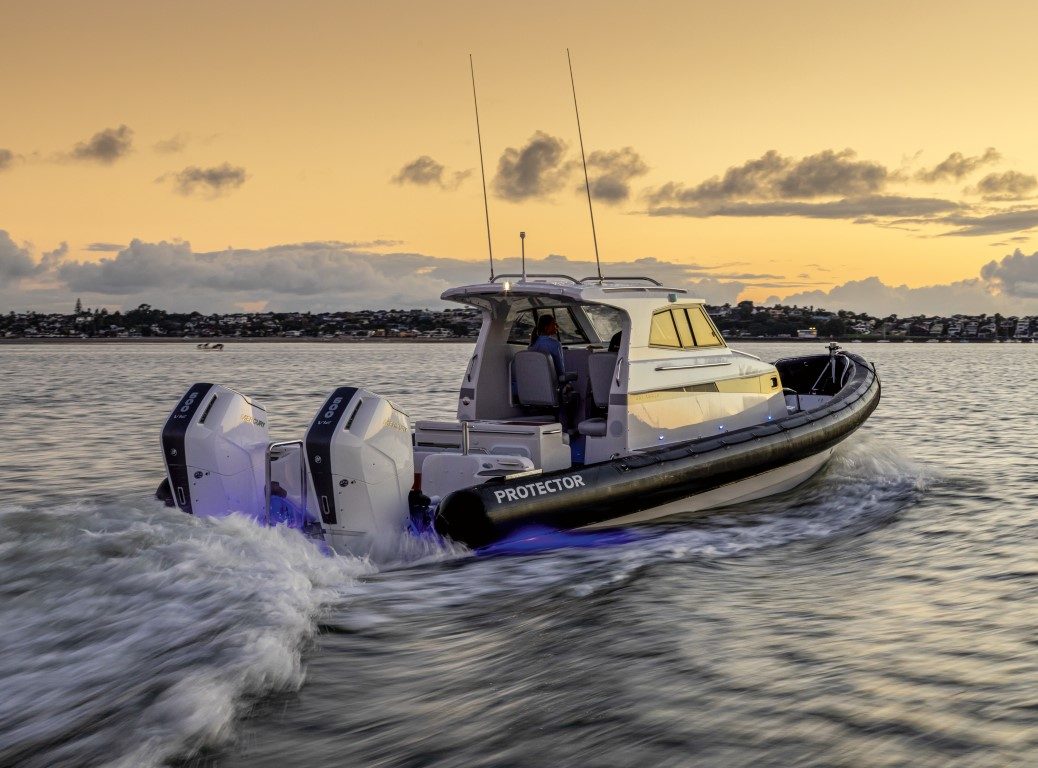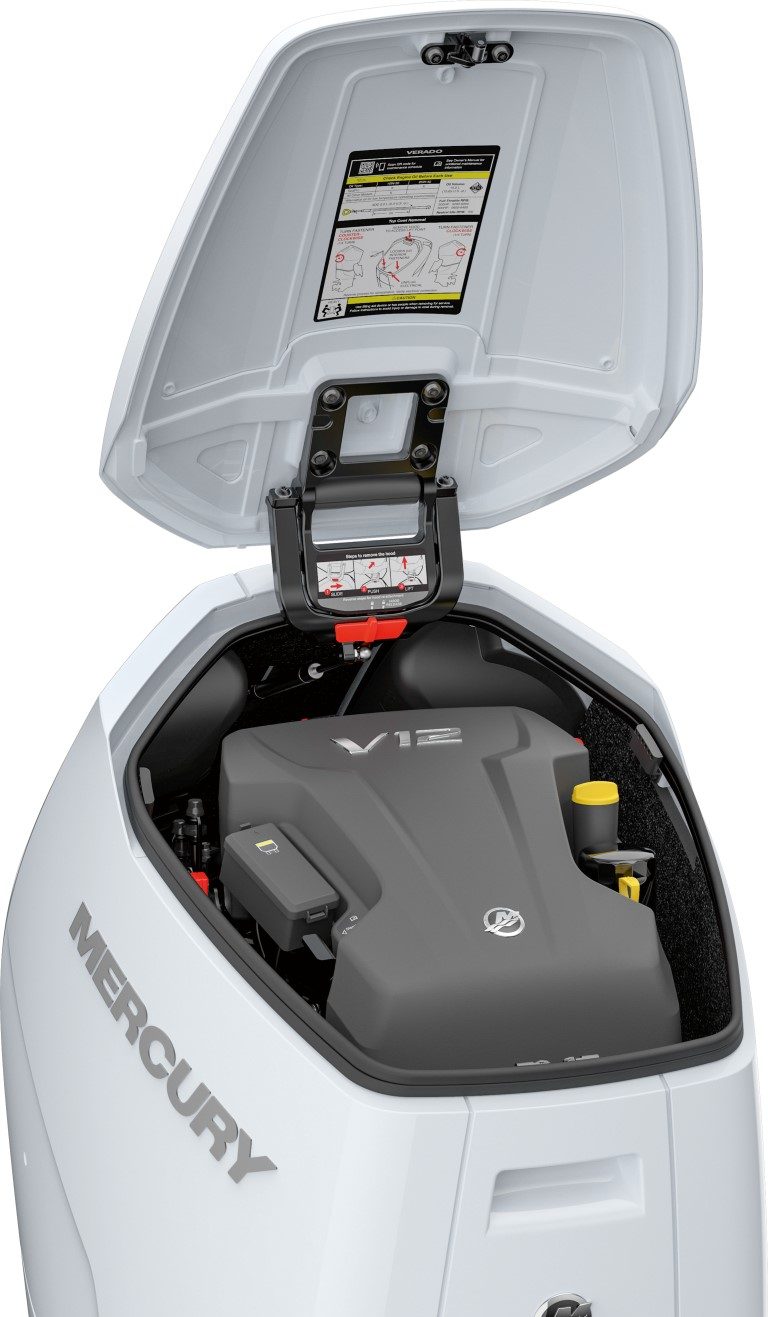

So, what’s it like to drive a big RIB with a pair of 600hp Mercury Verado outboards bolted to the transom?
In a word, awesome, for all the right reasons – shove-in-the-back acceleration, instant throttle response and blistering top speed, but also mechanical excellence, exceptional refinement and effortless operation.
Mercury’s most powerful outboard to date delivers on every level, including styling. Essentially two V6 Verado powerheads stacked end on end, the new V12 is a tall motor, but a cleverly-designed solid aluminium bracket compensates for the engine’s height and ensures it can be tilted completely clear of the water.
Available in black or white with understated graphics, Mercury’s Verado V12 is stylishly modern – muscular looking and well-proportioned.

Most powerful
The new 7.6-litre V12 Verado is currently the world’s most powerful production outboard, producing 600hp at the propshaft. The same V12 platform, engineered for commercial applications, is used in the 500hp SeaPro outboard.
The V12 Verado’s naturally-aspirated, large displacement quad-cam powerhead is a torque monster designed to power large centre-consoles, day boats, luxury cruisers and more – in our case an 8.5-tonne Rayglass Protector RIB – in single or multiple engine installations.
Rigorously tested over thousands of hours, the new outboard benefits from improved corrosion-inhibiting coatings and seals, an industry leading 150-amp alternator and enhanced engine monitoring systems to improve the overall boat ownership experience.
Mercury built the V12 Verado outboard to make maintenance easy. Capable of operating for 200 hours before requiring routine service, including oil changes, basic maintenance for this engine can be done through the top cowl service hood while the boat is still in the water. The entire cowl only comes off for more in-depth service at 1,000 hours or five years.

The new Verado is packed with engineering innovations, including industry-firsts for outboards: a two-speed automatic transmission and the outboard segment’s first steerable gearcase.
The streamlined, small diameter gearcase has dual, contra-rotating propellers with three blades in the rear and four blades at the front, providing outstanding hydrodynamic efficiency. Available in pitches up to 18 inches, these large diameter contra-rotating propellers transfer more thrust to the water and minimise slip, providing more rapid acceleration.
Unique steering
Steering is achieved by rotating the gearcase, which can pivot as much as 45° at low speed – far more than the 30–32° possible with a conventional outboard installation. Joystick control works even better, since there is a greater range of movement, while the contra-rotating configuration also makes docking manoeuvres easier by providing greater forward and reverse authority at slow speed.
The steerable gearcase offers numerous advantages. Digital steering is integrated, so no hydraulic hoses and mounting complications, and the powerhead – everything visible above the water – remains fixed in place. It doesn’t pivot on the transom to steer like a normal outboard does. For multiple rigs, this means the V12s can be mounted closer together, since the powerheads won’t interfere with one another, saving transom space. The lower units also tilt completely clear of the water.
Adjusting to the non-pivoting powerhead(s) is kind of odd at first, especially when backing up, since there is no visual clue as to which way the propellers are facing, but there’s a useful rudder angle indicator included in the digital display. You quickly get used to it.

Two speeds
The Verado’s two-speed automatic transmission works seamlessly, automatically selecting low gear for hole shots and slow speed manoeuvres and shifting to high gear at cruising speed and above.
Low gear is 20% lower than high gear, leveraging torque to accelerate the boat onto the plane more quickly; high gear delivers power all the way up to rated speed. Grab a handful of throttle and the transmission kicks down to propel the vessel forward, just like a car with an automatic transmission. Decelerate and the transmission automatically shifts down to low.
In practice, gear changes are almost imperceptible unless you concentrate on the rev counter. Hydraulic shifting – synchronised on multi-engine rigs – eliminates ‘shift clunk’, something we remarked on when using Mercury Joystick Piloting for Outboards.
The two-speed transmission also contributes to excellent fuel economy and exceptionally low sound levels, especially at cruising speed. We noted how smooth and quiet the twin engine installation was – the Protector 410 Targa has an open-backed hardtop, but we could easily hold a conversation underway.
Digital control
The V12 Verado outboard comes standard with Mercury’s Next Gen Digital Throttle & Shift (DTS) system. The new controls are sleek and ergonomic. Mercury has made them more intuitive by adding features like pushbutton access to Active Trim, which automatically adjusts trim for optimal performance. The dual-handle console-mount control for multi-engine boats includes an integrated digital display that connects boaters with valuable system information and helpful pop-ups.
Multi-engine controls have a start/stop-all button for all engines and buttons for starting and stopping individual engines, as well as the ability to trim all or individual engines.

Rayglass 410 Targa
The new Verado V12s were demonstrated on a custom-built Rayglass Protector 410 Targa.
These engines are the world’s first production outboards to feature a V12 powerhead, Mercury’s most powerful production engine to date, and the most powerful engines ever to be fitted on an RIB vessel. With a total of 1,200hp, the Protector has more power than the Aston Martin Valkyrie, a $5.18 million hyper-car.
Weighing almost twice as much as the 450hp outboards usually fitted to this Protector model, Rayglass had to re-engineer the vessel’s transom structure to make it strong enough to handle the weight and massive torque of the new V12 Verados.
Other custom features include enhanced seating, a recessed BBQ and new teak hatch lids. The vessel is fitted with three Ixnav screens that enable digital switching, push-button start, digital throttle technology, joystick piloting, Skyhook advanced controls and more, designed to make operating and monitoring the vessel as stress-free and easy as possible.
www.rayglass.co.nz




